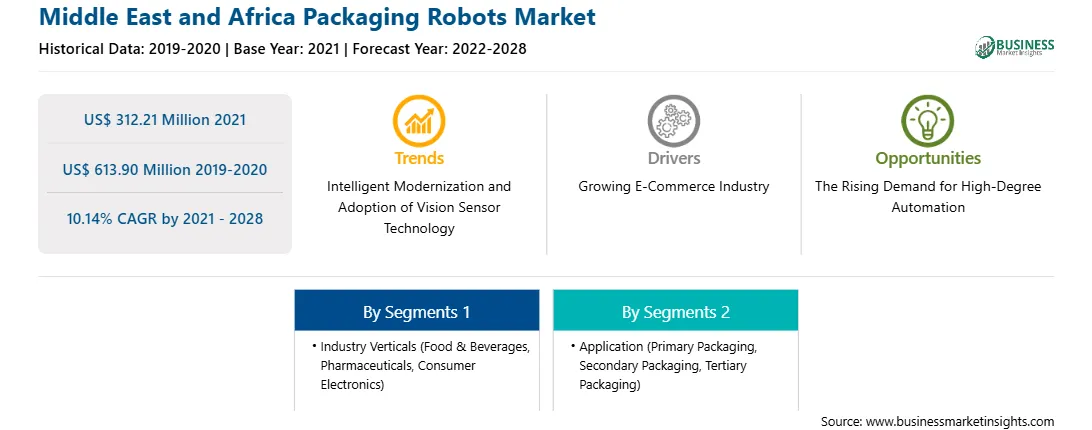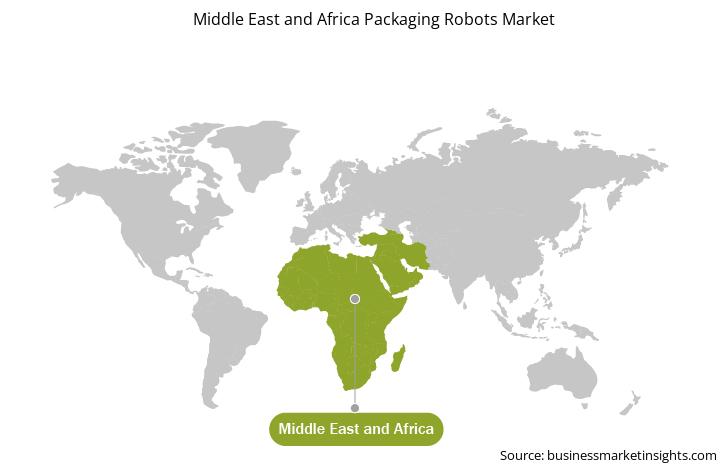Market Introduction
Packaging robots are the technologies used to automate the packaging operations across different industries such as consumer goods, consumer electronics, pharmaceuticals, e-commerce, food & beverage, chemicals, and personal care products sector. These robots are designed primarily for packaging operations such as material handling, moving or packing goods, sealing & labelling, and other tasks in order to sustain consistency, quality, and accuracy in packaging operations. There are primarily four different types of packaging robotic technologies used across different industries for packaging automation. This includes articulated robots, Cartesian robots, SCARA robots, and delta robots which are also called parallel link robots
Market Overview and Dynamics
The Middle East and Africa packaging robots market is expected to reach US$ 613.90 million by 2028 from US$ 312.21 million in 2021; it is estimated to grow at a CAGR of 10.14% from 2021 to 2028. The major factors driving the growth of market are the rising demand for packaging robots from several industries and growing demand for reducing the overall operation costs across packaging sector. However, the high deployment cost of packaging robots hampers the market growth.
Packaging methods for consumer-packaged goods must be precise and repeatable. Companies that use robotics in their packaging lines can improve throughput, efficiency, and quality. Individual packaging at high-cycle rates might be difficult. Robotics has proven to have a high return on investment in a variety of applications, including raw product handling, primary packaging, secondary packaging, and palletizing. Moreover, product branding and packaging are critical for producers to be competitive in today's market. Packaging, brand name, content, and pricing all influence customers' purchase patterns. Also, counterfeit items are a common problem for manufacturers in the food and beverage, pharmaceutical, and FMCG industries. Packaging robots are reliable and give high-quality branding information via labelling. After products are packaged, a unique identification code is generated, which aids in product tracking along the supply chain. Moreover, the main benefit of robotics in packaging sector is that they offer no doubt in flexibility. Line machinists can adjust the contour of a case or pallet load with the push of a button. This highlights the flexibility needed to satisfy trade customers that need more and more tailored cargoes, while not losing the accompanying speed. Furthermore, robotic packaging systems such as pick-and-place robots are equipped with slim arms and a wide reach, as well as solid repeatability and precision tooling, enabling them to be exceedingly precise and accurate. Because of their high precision, they're a good fit for a variety of packaging and supply chain tasks. Lastly, Product quality and cycle time can both be improved using robot packaging equipment. Because robotic actions are regulated, their consequences are always consistent, which enhances packing quality. The packaging procedures can run smoothly because of this consistency.
Middle East is one of the regions with several economies still in the nascent stage of technological adoption and developments. The COVID-19 pandemic is likely to accelerate the infrastructural developments in the region to keep businesses stable and profitable by optimizing production lines. However, the growth outlook for the region is neutral and depends on the government and private sector initiatives and investments. Due to the pandemic, Saudi Arabia, the UAE, Egypt, Morocco, and Kuwait are the main countries facing economic setbacks. The financial implications of the COVID-19 pandemic in these countries can push their developments backward and make them economically unstable for the long term.
Key Market Segments
Based on industry verticals, the Middle East and Africa packaging robots market is segmented into food & beverages, pharmaceuticals, consumer electronics, and others. The food & beverages segment held the largest market share in 2021. However, the pharmaceuticals segment is anticipated to register the highest CAGR during the forecast period.
Based on application, the Middle East and Africa packaging robots market is segmented into primary packaging, secondary packaging, and tertiary packaging. In 2021, the primary packaging segment held the largest market share. However, the secondary packaging segment is expected to register the highest CAGR from 2021 to 2028.
Major Sources and Companies Listed
Kuka AG, Fanuc Corporation, and Krones AG are among the key players operating in the Middle East and Africa packaging robots market.
Reasons to buy the report
MIDDLE EAST AND AFRICA PACKAGING ROBOTS MARKET SEGMENTATION
By Industry Verticals
By Application
By Country
Company Profiles
Strategic insights for the Middle East and Africa Packaging Robots provides data-driven analysis of the industry landscape, including current trends, key players, and regional nuances. These insights offer actionable recommendations, enabling readers to differentiate themselves from competitors by identifying untapped segments or developing unique value propositions. Leveraging data analytics, these insights help industry players anticipate the market shifts, whether investors, manufacturers, or other stakeholders. A future-oriented perspective is essential, helping stakeholders anticipate market shifts and position themselves for long-term success in this dynamic region. Ultimately, effective strategic insights empower readers to make informed decisions that drive profitability and achieve their business objectives within the market.

| Report Attribute | Details |
|---|---|
| Market size in 2021 | US$ 312.21 Million |
| Market Size by 2028 | US$ 613.90 Million |
| Global CAGR (2021 - 2028) | 10.14% |
| Historical Data | 2019-2020 |
| Forecast period | 2022-2028 |
| Segments Covered |
By Industry Verticals
|
| Regions and Countries Covered | Middle East and Africa
|
| Market leaders and key company profiles |
The geographic scope of the Middle East and Africa Packaging Robots refers to the specific areas in which a business operates and competes. Understanding local distinctions, such as diverse consumer preferences (e.g., demand for specific plug types or battery backup durations), varying economic conditions, and regulatory environments, is crucial for tailoring strategies to specific markets. Businesses can expand their reach by identifying underserved areas or adapting their offerings to meet local demands. A clear market focus allows for more effective resource allocation, targeted marketing campaigns, and better positioning against local competitors, ultimately driving growth in those targeted areas.

The Middle East and Africa Packaging Robots Market is valued at US$ 312.21 Million in 2021, it is projected to reach US$ 613.90 Million by 2028.
As per our report Middle East and Africa Packaging Robots Market, the market size is valued at US$ 312.21 Million in 2021, projecting it to reach US$ 613.90 Million by 2028. This translates to a CAGR of approximately 10.14% during the forecast period.
The Middle East and Africa Packaging Robots Market report typically cover these key segments-
The historic period, base year, and forecast period can vary slightly depending on the specific market research report. However, for the Middle East and Africa Packaging Robots Market report:
The Middle East and Africa Packaging Robots Market is populated by several key players, each contributing to its growth and innovation. Some of the major players include:
The Middle East and Africa Packaging Robots Market report is valuable for diverse stakeholders, including:
Essentially, anyone involved in or considering involvement in the Middle East and Africa Packaging Robots Market value chain can benefit from the information contained in a comprehensive market report.